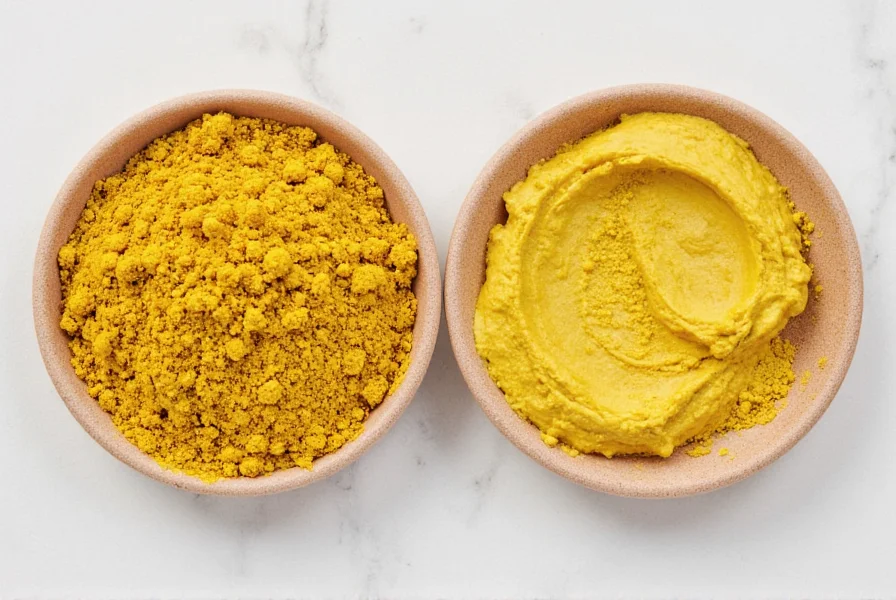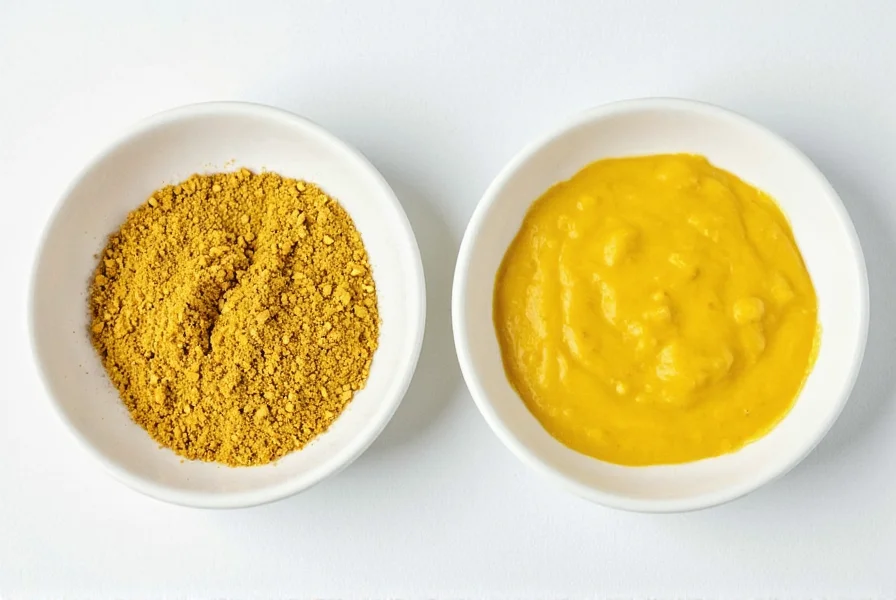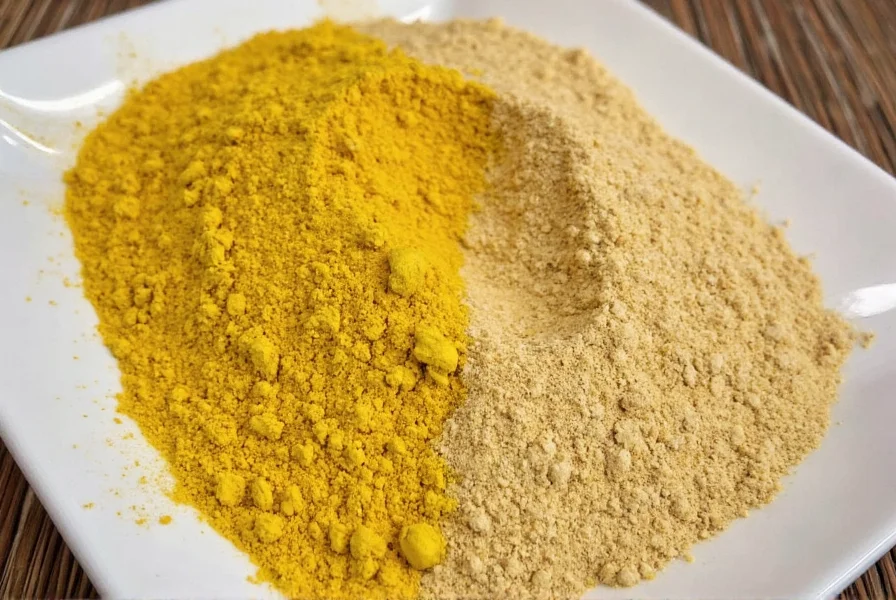No, mustard seed powder and mustard condiment are not the same. Mustard seed powder is a dry spice made from ground mustard seeds, while prepared mustard is a ready-to-use condiment created by mixing mustard seed powder with liquids like vinegar, water, or wine. The key difference is that mustard seed powder requires activation with liquid to release its full flavor and heat, whereas prepared mustard has already undergone this enzymatic reaction and delivers immediate tangy, spicy flavor.
| Feature | Mustard Seed Powder | Prepared Mustard |
|---|---|---|
| Form | Dry powder | Paste/liquid |
| Main Ingredient | Ground mustard seeds | Mustard seed powder + liquid + spices |
| Heat Activation | Requires liquid (especially acidic) to activate | Already activated and ready to use |
| Primary Use | Base for homemade mustard, spice rubs, marinades | Condiment, sandwich topping, dressing base |
| Storage | Room temperature, sealed container | Refrigerate after opening |
What Is Mustard Seed Powder?
Mustard seed powder comes from grinding dried mustard seeds into a fine texture. These seeds can be yellow, brown, or black, each bringing a slightly different flavor profile. Once ground, the powder becomes a versatile ingredient that can be used as a base for homemade mustard, in spice blends, or as a dry rub for meats.
- Made from: Ground mustard seeds (yellow, brown, or black)
- Form: Dry, powdery texture
- Common Uses: Making homemade mustard, spice rubs, marinades, and curries
- Shelf Life: Up to 3 years when stored properly

What Exactly Is Mustard (the Condiment)?
When most people say "mustard," they're referring to the creamy, tangy condiment you smear on sandwiches or dip pretzels into. But did you know that this ready-to-use product is made by mixing mustard seed powder with liquid ingredients like water, vinegar, wine, or beer? That reaction unlocks the signature pungency and heat we associate with mustard.
- Made from: Mustard seed powder + liquid (vinegar, water, etc.) + spices
- Form: Paste-like consistency
- Common Types: Yellow, Dijon, Whole Grain, Honey Mustard, German, English, etc.
- Shelf Life: 1–2 years refrigerated after opening
Flavor Profiles Compared
The key difference in flavor comes down to activation. Mustard seed powder only begins to release its full aroma and spiciness when mixed with a liquid — especially acidic ones like vinegar or lemon juice. Prepared mustard has already undergone this process, giving it an immediate, sharp bite.
- Mustard Seed Powder: Earthy, nutty, with potential heat when wet
- Prepared Mustard: Tangy, spicy, complex depending on the recipe and ingredients used

Practical Cooking Tips: When to Use Which?
Let's break it down into real-world kitchen situations so you never have to guess again.
Use Mustard Seed Powder When:
- You want to make homemade mustard from scratch
- You're creating spice rubs for meats or veggies
- Adding depth to marinades, sauces, or pickling brines
- Looking for a subtle warmth without overpowering flavors
Use Prepared Mustard When:
- Smearing on sandwiches or burgers
- Mixing into salad dressings or vinaigrettes
- Glazing meats or using as a base for dips
- You need that unmistakable mustard punch immediately

Buying Guide: Choosing the Right One for You
Choosing between mustard seed powder and prepared mustard really depends on how you plan to use it and how much time you want to invest. Here's a quick buying guide tailored to different types of users:
For Home Cooks
- Best Mustard Seed Powder: McCormick Ground Mustard – reliable, consistent quality
- Best Prepared Mustard: Grey Poupon Dijon – smooth, bold, perfect for gourmet flair
For Spice Enthusiasts
- Artisan Mustard Seed Powder: Savory Spice Shop Brown Mustard Seed Powder – great for experimenting
- Gourmet Mustard Brands: Maille Moutarde Ancienne (French), Amora Moutarde de Meaux (French), or local small-batch options
For Quick Meals & Everyday Use
- Budget-Friendly Mustard: French's Classic Yellow Mustard – affordable and classic
- Versatile Seed Powder: Simply Organic Ground Mustard – organic and multipurpose
For Specialty Recipes
- Whole Grain Mustard: Maille Whole Grain – adds texture and complexity
- Spicy Mustard Seed Powder: Spicy World Black Mustard Powder – for those who like it hot
Frequently Asked Questions
Are mustard seed powder and prepared mustard the same thing?
No, they are not the same. Mustard seed powder is a dry spice made from ground mustard seeds, while prepared mustard is the condiment you typically find in jars that contains mustard seed powder mixed with liquids and other ingredients.
Can I substitute mustard seed powder for prepared mustard in recipes?
You can, but with adjustments. For every tablespoon of prepared mustard, use 1 teaspoon of mustard seed powder mixed with 2 teaspoons of liquid (water, vinegar, etc.). Keep in mind the flavor profile will differ slightly, as prepared mustard has already undergone the enzymatic reaction that creates its characteristic heat.
What's the main difference between mustard seed powder and prepared mustard?
The main difference is that mustard seed powder is a dry ingredient that only develops its full flavor when mixed with liquid, while prepared mustard is the ready-to-use condiment where this reaction has already occurred. Mustard seed powder has a longer shelf life and more versatile cooking applications, while prepared mustard delivers immediate flavor.
How do I make mustard from mustard seed powder?
Mix 2 tablespoons of mustard seed powder with 3 tablespoons of cold liquid (water, vinegar, wine, or a combination). Let it sit for 10-15 minutes to develop flavor, then add salt, sweeteners, or other spices to taste. The mixture will thicken as it sits. For creamier mustard, blend with a small amount of oil.
Does mustard seed powder expire?
Mustard seed powder doesn't technically expire but loses potency over time. Properly stored in an airtight container away from light and moisture, it maintains good flavor for 2-3 years. It won't make you sick if older, but the flavor and heat will diminish significantly.
Why does prepared mustard taste spicier than mustard seed powder?
When mustard seed powder mixes with liquid (especially acidic liquids like vinegar), an enzymatic reaction occurs that releases allyl isothiocyanate - the compound responsible for mustard's heat. In dry powder form, this reaction hasn't happened yet, so the heat is dormant until activated by moisture.
Can I make my own prepared mustard at home?
Absolutely! Making your own mustard allows you to control the ingredients and customize flavors. Simply mix mustard seed powder with your choice of liquid (water, vinegar, wine, beer), let it sit to develop heat, then add salt, sweeteners, and other spices. Homemade mustard actually improves in flavor after sitting for a few days.
Which is healthier: mustard seed powder or prepared mustard?
Both are low in calories, but mustard seed powder is purer with no added ingredients. Prepared mustards often contain added sugars, preservatives, or thickeners. If you're watching sodium or sugar intake, making your own mustard from seed powder gives you complete control over what goes into it.
Conclusion: Yes, There's a Big Difference!
In summary, while both mustard seed powder and prepared mustard come from mustard seeds, they are not interchangeable. One is a dry spice with latent power, and the other is a fully formed condiment ready to deliver flavor instantly. Understanding when and how to use each opens up a world of culinary possibilities — from homemade creations to enhancing everyday meals.










 浙公网安备
33010002000092号
浙公网安备
33010002000092号 浙B2-20120091-4
浙B2-20120091-4